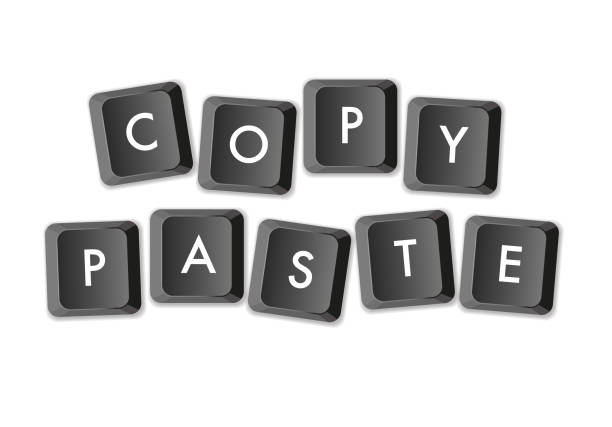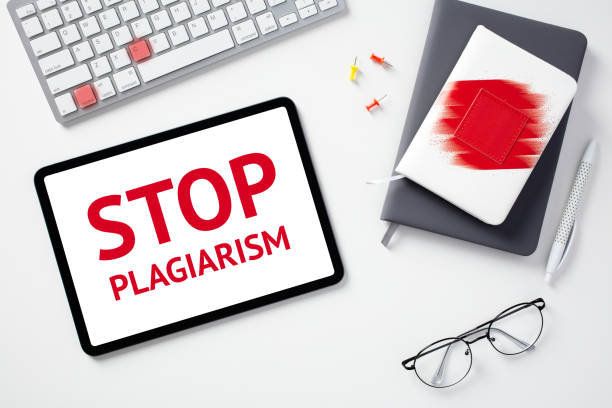You’ve probably heard of plagiarism and how it can ruin years of building credibility as a freelancer, student, academic writer, or any word-related work.
It’s the most common issue that is faced in the writing community, whether it is a research paper, dissertation, or article.
It’s easy to take someone else’s idea and present it as yours, but the consequences that come with it can be pretty severe.
Many Nigerian freelancers who plagiarize know what they are doing, while some do it unintentionally. Either way, it’s not fair to the original owner of the work or idea.
This is why I have put together this article that explains exactly what plagiarism is, the common types of plagiarism, and how to avoid them.
This can help you avoid intentional or unintentional stealing, borrow ideas without plagiarizing, and lead you to produce original, valuable works.
Ready! Let’s dive in!
Table of Contents
What is Plagiarism?

Computer Keys Keyboard with lettering composing Copy/Paste Concept
Plagiarism is presenting someone’s words, thoughts, or ideas as your own without giving proper credit to the original owner. This might seem like a simple act of borrowing, but the action is a serious offense; in fact, it’s a blatant fraud that can land you in serious trouble and can damage your career in the long run.
Morally and legally, it’s wrong!
Imagine working on a write-up, books, content, etc., for a very long time, and someone else infringes on your work and takes ownership of that work without giving proper accreditation to you. It’s quite infuriating.
Plagiarism usually occurs when one is in a tight situation or on a deadline.
As we go into the article, I’ll explain the different types of plagiarism and how to avoid them.
7 Types of Plagiarism

Original or copy
-
Direct or cloning plagiarism
Direct plagiarism, also called “cloning,” involves copying the work of another, word-for-word, without any change whatsoever and claiming it as yours. This type of plagiarism is deliberate and problematic.
The plagiarizer thought
“Oh! I have no time to do any research; I’ll just copy this work I like and use it as mine.”
So they copy and paste it verbatim as theirs. Direct plagiarism is dishonest and is a serious offense, even if you credit the author; it doesn’t matter because you’re copying and pasting their work without putting any effort into creating your idea.
-
Global plagiarism
This type of plagiarism is very common among students. It happens when you get credit for work you did not do. It’s very misleading as it involves
- Paying someone else to write in your stead and taking full authorship of the work
- Taking total credit for a work, assignment, copy, article, or thesis done in a group.
Have you ever read a book or watched a movie where a character steals the work of another and portrays it as theirs?
That is global plagiarism. This type of plagiarism often comes up when one is under pressure or has a deadline to meet.
-
Find – replace plagiarism
This is where some of our Nigerian brothers apply what they call “smart work,” but it’s not.
It’s just like direct plagiarism, but the plagiarizers believe they can get away by simply changing some keywords and phrases on the original document without making any changes to the essential document.
The find–replace the type of plagiarism is usually intentional; it’s the wrong way to paraphrase.
Despite the change of a few words, this plagiarism can still be detected using plagiarism tools.
-
Paraphrasing or accidental plagiarism
Paraphrasing or accidental plagiarism is simply rephrasing or, in simpler words paraphrasing a piece of text in someone’s work without giving them credit for it.
This type of plagiarism is very common. It’s also known as recycling. It’s taking a portion of someone’s words, thoughts, or ideas, putting it differently, and taking full credit for that word or idea without giving any credit to the original owner of the idea.
Just to make things clear, paraphrasing correctly is not plagiarism if you cite your sources correctly. It only becomes plagiarism when you find a source you like, rewrite the key points as if it were your ideas, and still do not cite the source from which you took that piece of content.
NB: Translation from one language to another without attributing to the original author is still plagiarism since it’s someone’s idea.
Read also: Content Editing for Seo [A Full Guide To Edit Your Content For Seo]
-
Mosaic or remix plagiarism
This plagiarism is also called “Patchwork plagiarism.”
You can probably tell from the name “remix and patchwork” that this plagiarism is copying phrases or text from different sources and putting them together as a new document.
Many people often call this “research,” but research is entirely different and requires good paraphrasing skills.
What’s the difference?
According to the Cambridge dictionary, research is a “detailed study of a subject, especially to discover new information or reach a new understanding.” Notice how it says “detailed study and reaches new understanding”? That’s the difference.
Mosaic plagiarism is one that people often fall into when they’re desperate, either trying to meet a timeline or deadline. Instead of spending time studying and understanding the topic in question, they find sources that would fit what they’re looking for; they copy bits from them and fit them together.
This type of plagiarism usually appears authentic as it can be difficult to detect since the content mingles with phrases from several contents and the author’s ideas.
Advanced plagiarism tools can still detect it.
-
Self-plagiarism
Self-plagiarism is reusing a portion of text from your previous work.
In simple terms, it’s plagiarizing yourself.
Many people don’t see this type of plagiarism as a problem since they wrote it. But it’s still plagiarism.
Let’s say you wrote a fabulous paper two years ago, and you needed another one this year. Taking information from a past paper is flagged as plagiarism.
Once what you’ve written has either been submitted or published, it’s no longer yours. If you, by any chance, need to take a piece of text from that content, you need to cite yourself to avoid this type of plagiarism.
Read also: Improve Your Writing: 7 Little Things that Make a Huge Difference in Writing
-
Incorrect or incidental citation
This type of plagiarism occurs when you do not cite your source correctly. When you make a mistake with the name or date of authorship, forget quotation marks, give nonexistent citations, or your citation is not formatted according to citation formats or styles like APA (American psychology association), MLA (modern language association), Chicago Style, etc.
Incidental plagiarism can also occur when your writing does not correspond with the sources you provided. When writing an academic paper, it is often referred to as “academic cheating.” People who indulge in this type of plagiarism either make their citations carelessly or do not know how to cite sources correctly.
How to Avoid the Various Types of Plagiarism

Stop plagiarism.
-
Always cite your sources and cite them correctly
One of the simplest ways to avoid plagiarism is by citing your sources. Whenever you use an idea or words that are not your own, always quote and cite the original author correctly, following the correct style guide required for your writing.
To avoid making incorrect citations, it’s advisable to keep track of whatever source you get your ideas from, e.g., By taking notes of the author, title, website, and page number. This will make your referencing and citation easier.
If you’re writing an academic paper, it’s important to not just cite in the body of the paper but also have a reference list or bibliography at the end of your paper where you give details of the sources you’ve cited.
-
Paraphrase the right way
As I said at the beginning of this article, paraphrasing is not plagiarism if done correctly. Paraphrasing is wording information from a source in your own words without changing the idea. It’s a skill that takes practice.
Using words or phrases that are too similar to the source can slowly slip into plagiarism. It’s still important to cite the source, even though you’re paraphrasing.
Read also: How to Become a Successful Freelance Writer in Nigeria
-
Use a plagiarism checker
There are circumstances where people plagiarism without knowing it. Using a plagiarism checker to detect plagiarism is a great way to avoid accidental plagiarism.
This software compares your writing to those other writers have written and highlights their similarities.
There is a lot of plagiarism software online, and it’s important to keep their level of accuracy in mind. Some of this software are:
It’s one of the most widely used paid plagiarism and grammar checkers online. They have a large database of books, research journals, and documents.
They provide you with more accurate and proper results. You can create an account and upload any document to check for plagiarized content.
This free plagiarism checker allows you to upload up to 2000 words of your document. It’s arguably one of the best free plagiarism checkers online.
It’s a free checker that provides a free trial when you create an account with them. It gives a more detailed report on your plagiarized content. The free version only allows you to copy-paste or type in your document, but the paid version allows you to upload your documents.
It is a free online plagiarism checker that allows you to upload documents with a word limit of 1000 words. It also has a paid plan where you can unlock deep searches with no word limit.
This free checker matches your document with articles and documents on the web. It comes with a 1000-word limit in the free plan.
TIP: Keep your plagiarism score in single digits, i.e., 5% and under
-
Begin early
One of the major reasons people plagiarize is pressure. When you don’t have the time for research, you end up using someone’s work.
It’s essential to begin early so that you have enough time to do your research, understand the topic you’ve been given, and write without indulging in any of the types of plagiarism listed above.
Conclusion
You should note that it’s very easy for you to plagiarize and very easy to lose your credibility; this is why it’s very important to do your research diligently and carefully.
So when next you have the temptation to plagiarize or copy and paste…Don’t!
With knowledge of the types of plagiarism and how to avoid them, Original content that is free of plagiarism becomes a possibility for you.
Do you have anything to say about this post? You are free to speak your mind in the comments section. You can also have an audience with Insight.ng via our WhatsApp community. Perhaps this post inspires you, kindly follow our Twitter page to keep track of more interesting posts. You can also subscribe to our newsletter. Insight.ng has always got your back!
About Author
-
Esther Onyeije is a freelance content writer who specializes in writing Blog posts, Articles, and social media posts for blogs and websites.
She uses her background in writing to provide solutions to the pain points of your target audience and create clear and accessible content that makes challenging topics easy for any reader.
Latest entries
 CareerNovember 30, 2023How to Make Money on Twitter
CareerNovember 30, 2023How to Make Money on Twitter

 CareerMarch 20, 2023A Comprehensive Guide to Searching for International Remote Jobs as a Nigerian
CareerMarch 20, 2023A Comprehensive Guide to Searching for International Remote Jobs as a Nigerian

